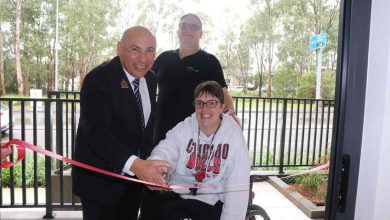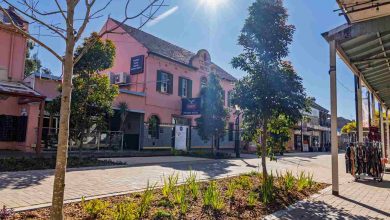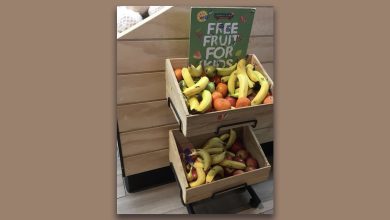THOMPSON’S CORNER, WEST PENNANT HILLS
Thomas Thompson (b.1794 – d.1872) was a convict who arrived in the colony in 1815, with a seven-year sentence for larceny.
He married the daughter of a convict, Hannah Russell in 1819, and worked on his father in-law’s land in the Pennant Hills district. In 1824, he successfully applied for land adjacent to his in-law’s land. Today, Thompson’s land grant is on New Line Road.
Despite serving his sentence, Thompson continued to be on the wrong side of the law. In 1821, he was convicted of working a still to produce sly grog in a cave in North Rocks and he had unsuccessfully tried to bribe the two arresting constables. He was fined £20 and sentenced to three years hard labour. It was also said that Thompson ran a still near modern day Pennant Hills railway station, which produced cheap grog for local farm labourers. This was also raided at one stage. By 1828, Thomas Thompson was free by servitude and had 50 acres, known as Thompson’s Farm.
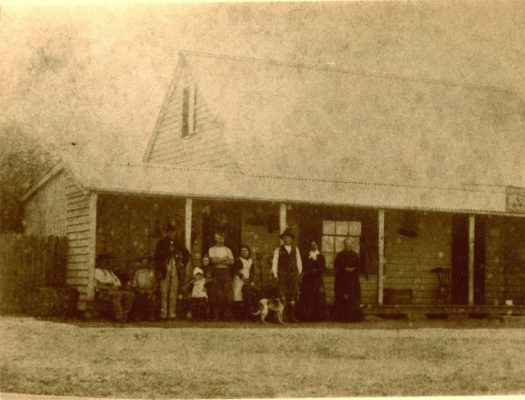
He was working as a timberman with several convicts and ticket-of-leave sawyers under his charge. However, he was soon in trouble again. A convict serving Thompson’s neighbour, Thomas Bellamy, was caught with Thompson’s Certificate of Freedom in 1832.
The convict, John Druitt, had a similar appearance to Thompson and when interviewed by police about why he had not reported his missing Certificate, Thompson pleaded ignorance. It was claimed by police that Thompson had previously served in the same gang as Druitt and that he had illegally employed Druitt to transport his timber to Sydney.
The outcome was that Thompson was prohibited from having any convicts and this was a serious disadvantage to his business. Nevertheless, Thompson continued to do well and acquired more land when his father in-law, Henry Russell died in 1838.
Thomas and Hannah Thompson had two sons. One named after their father, Thomas Jnr, and one named after the grandfather, Henry. They also had nine daughters. Mary-Ann was the eldest daughter and in 1838, she married Joseph Harrison.
Mary-Ann had inherited around 65 acres from her maternal grandparents (the Russells) on which Mary-Ann and Joseph established a farm, with a mixed orchard, that they named “Cherrybrook”.
They raised 13 children (4 boys and 9 girls) on their farm, which later provided the name for the local suburb. The second eldest daughter was Matilda, who, at 19 years of age, married Joseph Sanday. In 1864, he purchased land from Francis Allsop, who had married another Thompson daughter (Rachel).
There Sanday built a store in the area then known as Pennant Hills. The store was situated on the northern side of the intersection between Castle Hill and Pennant Hills Roads. In 1867, Sanday also became the district’s first Postmaster and established Pennant Hills Post Office within his store.
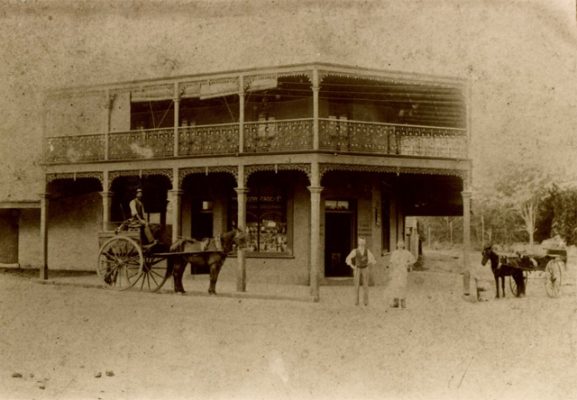
In 1877, Sanday’s brother in-law, Thomas Thompson Jnr, who was originally an orchardist in the local area, purchased the store for £175, which did not include the Post Office.
That year James Smith built a new Post Office and store together with his impressive stone house, on the southern side of the intersection, directly across the road from Thompson’s store. In 1898, a Post Office was established near the new railway station at Pennant Hills.
At that time the existing Post Office at Thompsons Corner became known as West Pennant Hills. The run-down weatherboard store building which Thompson purchased, was destroyed by fire in 1890. He replaced it with an impressive two-storied building with two entrances.
On one side of the ground floor was the shop, divided by an archway. On the other side was a kitchen, dining room and two or three other rooms. Upstairs were the bedrooms for Thomas Thompson’s large family.
The upstairs balconies were finished with fine cast-iron verandah trims and offered impressive views all the way to Sydney town, Parramatta and the Blue Mountains. Thompson’s store became a well-known landmark, and this is what gave the name to “Thompsons Corner”.
The first reference to Thompson’s Corner was in the Town and Country Journal newspaper on 3rd March 1888 which read: “On the high ridge along which the Parramatta road runs, and at the junction of the road going to the Pennant Hills station is a little hamlet rejoicing in this style and title of Thompson’s Corner. Around this pretty focus are gathered many fine orchards.”
Sanday used to offer his goods to the surrounding districts by regularly taking a loaded horse and cart as far as Dural and Pearces Corner. Thompson and his sons continued this service and many of the residents from modern day areas of Hornsby and Wahroonga would meet the store’s cart at Pearces Corner to put in an order for the next visit or purchase their basics that were carried on the cart such as meat, flour and sugar.
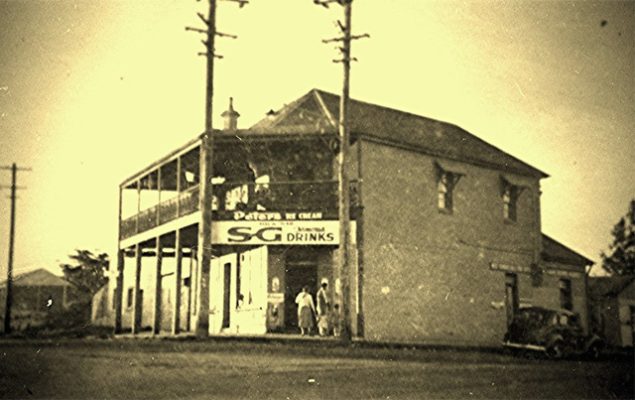
Thompson also established a bakery behind his home and made his son, Ernest, chief baker. He supplied bread to both local residents and to the many extra workers in the area during the construction of the Strathfield to Hornsby railway. Thompson and his wife had ten sons to help them in the bakery and store. For twenty years the Thompson family built up their businesses until they sold out in 1897, for £2,500.
It was purchased by Richard Steer. His wife Phoebe Steer, was Henry Lawson’s aunt, and the Steers had 3 sons and seven daughters to help them run the businesses. In his youth, Steer had gone to work for a butcher at Gulgong, during the Gold Rush period.
He later became a master baker in Gulgong and owned the bakery featured on the old $10 note, along with Henry Lawson. Steer was a very community spirited man and was elected as Gulgong Mayor for 14 years.
Upon arrival at Thompsons Corner, Richard Steer threw himself into local affairs by becoming President of the Fruitgrowers Association and a member of the Progress Association. He also added impressive stables behind the shop.
However, the new owner was not successful and within twelve months bad debts had accumulated and the business had slumped. One reason for its failure was that new shops opened in modern day Pennant Hills, around the railway station.
This was something Thomas Thompson Jnr had anticipated, and he established a shop near Pennant Hills railway station, and it was managed by his son. Thompson’s new store took considerable business away from his former store located two miles south.
A Mr Alcock from Newcastle bought out Steer’s businesses (but not the building). Alcock remained until 1902 when his wife’s health forced him to leave the district and he sold the business to Major George Morris. The Major was a Boer War veteran, and he reorganized the store with military precision bringing in up to date lines.
The Major’s restructure left the store well stocked with general lines, groceries, materials and even fine china. However, fortune was not with the veteran for within 12 months he had contracted pneumonia. He sold the business to Scotsman and former banker, Mr JF Arnot who, for his own health reasons, put in his brother in-law to manage the store and a Mr Miller to run the bakery.
Mr Arnot was a kind man and made many donations of sandwiches and cakes to various local charities. He had an employee who drank a lot, so, to protect him and his family, and ensure they had enough food, he paid the man partly in cash and partly in goods. Unfortunately, he found himself in court, unsuccessfully defending his payment method as he could not legally pay employees with goods.
He sold out of the business in 1911 and it was around this time that the bakery closed. From 1911 to 1918 the Harrison family ran the store, before it was sold to the Russell brothers who ran it until 1924.
Since 1897, Richard Steer had continued owned the property, despite being declared bankrupt that year. In 1925 he sold it to Mrs Mary Green. She leased the business to James Smith and, in 1927, Thorby and Yeo purchased the property.
JW Thorby ran the business and was also appointed Postmaster. Despite the first years of operation coinciding with the Great Depression, Thorby was very successful. He also made available the old bakery building for Church Services and youth activities.
Jack Thorby and his family were connected to the local area for the next fifty years. In 1949, the grocery section of their business was sold to the Twyman and Clark families who traded in the building as The TCT Stores until it was demolished in 1961 for the widening of Pennant Hills Road.
When a new shopping complex was built, Thorbys owned and operated a hardware, newsagency and Post Office. Thorby senior died in 1966 and his son Ken passed away in 1975.
Thorby’s large building was converted to an arcade. A Coles supermarket opened behind the arcade on 25th October 1972 and their building was first upgraded in 1997, and has been again since, to meet the changing needs of the modern shopper.
When Pennant Hills Road was again widened, it was necessary to round Thompsons Corner to allow for an easier flow of traffic. In July 1995, a short road tunnel, under Pennant Hills Road, was built at Thompsons Corner to alleviate the serious traffic congestion at the intersection with Castle Hill Road.
Source: Hornsby Shire Historical Society




